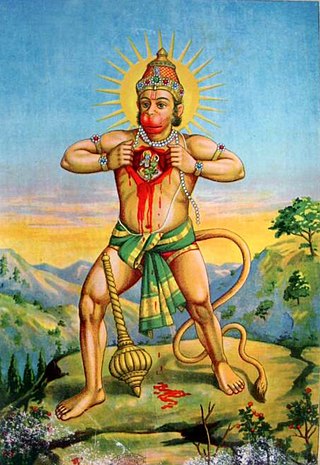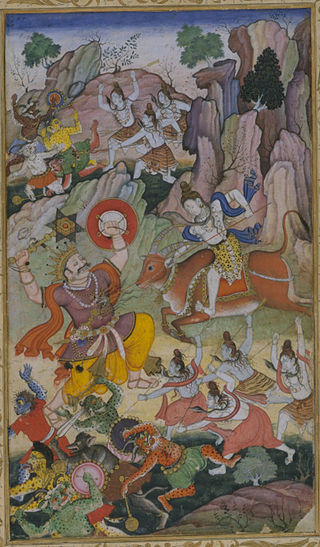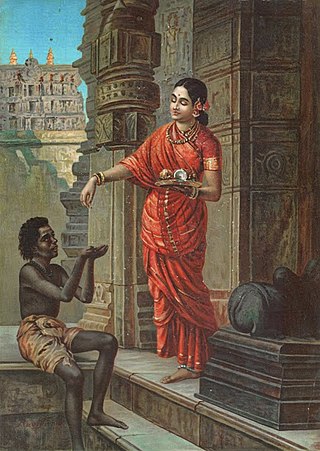
The Ramayana is a smriti text from ancient India, one of the two important epics of Hinduism known as the Itihasas, the other being the Mahabharata. The epic, traditionally ascribed to the Maharishi Valmiki, narrates the life of Rama, a prince of Ayodhya in the kingdom of Kosala. The epic follows his fourteen-year exile to the forest urged by his father King Dasharatha, on the request of Rama's stepmother Kaikeyi; his travels across forests in the Indian subcontinent with his wife Sita and brother Lakshmana; the kidnapping of Sita by Ravana, the king of Lanka, that resulted in war; and Rama's eventual return to Ayodhya along with Sita to be crowned king amidst jubilation and celebration.

Ravana is a multi-headed rakshasa king of the island of Lanka, and the chief antagonist in the Hindu epic Ramayana. In the Ramayana, Ravana is described as the eldest son of sage Vishrava and Kaikasi. He abducted Prince Rama's wife, Sita, and took her to his kingdom of Lanka, where he held her in the Ashoka Vatika. Rama, with the support of vanara King Sugriva and his army of vanaras, launched an invasion against Ravana in Lanka. Ravana was subsequently slain, and Rama rescued his beloved wife Sita.

Hanuman, also known as Maruti, Bajrangabali, and Anjaneya, is a deity in Hinduism, revered as an avatar of Shiva, divine vanara, and a devoted companion of the deity Rama. Central to the Ramayana, Hanuman is celebrated for his unwavering devotion to Rama and is considered a chiranjivi. He is traditionally believed to be the spiritual offspring of the wind deity Vayu, who is said to have played a significant role in his birth. His tales are recounted not only in the Ramayana but also in the Mahabharata and various Puranas.

In Hinduism, Ahalya also known as Ahilya, is the wife of the sage Gautama Maharishi. Many Hindu scriptures describe her legend of seduction by the king of the gods Indra, her husband's curse for her infidelity, and her liberation from the curse by the god Rama.

In Hindu literature, Andhaka refers to a malevolent asura, whose pride is vanquished by Shiva and Parvati.

Lakshmana, also spelled as Laxmana, is the younger brother of Rama and his loyalist in the Hindu epic Ramayana. He bears the epithets of Saumitra and Ramanuja. He is the twin of Shatrughna.

Shatrughna is a prince of Ayodhya, King of Madhupura and Vidisha, and a brother of Prince Rama in the Hindu epic Ramayana. He is also known as Ripudaman. He is the twin of Lakshmana. He is a loyalist of Bharata, just like Lakshmana is to Rama. According to the Valmiki Ramayana, Shatrughna is an incarnation of the Sudarshana Chakra. Shatrughna also appears as the 412th name of Vishnu in the Vishnu Sahasranama of the Mahabharata.

Vali also known as Bali, was a vanara and the king of Kishkindha in the Hindu epic Ramayana. He was the husband of Tara, the son of Indra, the elder brother of Sugriva, and the father of Angada.

Ramcharitmanas, is an epic poem in the Awadhi language, based on the Ramayana, and composed by the 16th-century Indian bhakti poet Tulsidas. This work is also called, in popular parlance, Tulsi Ramayana, Tulsikrit Ramayana, Tulsidas Ramayana or simply Manas. The word Ramcharitmanas literally means "Lake of the deeds of Rama". It is considered one of the greatest works of Hindu literature. The work has variously been acclaimed as "the living sum of Indian culture", "the tallest tree in the magic garden of medieval Indian poetry", "the greatest book of all devotional literature" and "the best and most trustworthy guide to the popular living faith of the Indian people".

Mandodari was the queen consort of Ravana, the king of Lanka, according to the Hindu epic Ramayana. The Ramayana describes her as beautiful, pious, and righteous. She is extolled as one of the Panchakanya, the recital of whose names is believed to dispel sin.

Shrutakirti is a princess featured in the Hindu epic Ramayana. She is the daughter of King Kushadhvaja and queen Chandrabhaga. She is the wife of Shatrughna, the younger brother of Rama. Shrutakirti is considered to be an incarnation of the disc of the goddess Lakshmi.

Mandavi is a princess and the elder daughter of King Kushadhvaja and Queen Chandrabhaga in the Hindu epic Ramayana. She is married to Bharata, a younger brother of Rama. Mandavi is considered to be an incarnation of the conch shell of Lakshmi.
The Ananda Ramayana is authored by Valmiki Maharishi. The text has received little attention from scholars, though in some traditions, it is considered a principal source of Rama stories.
Ramleela – Ajay Devgn Ke Saath, commonly known as Ramleela is a mythological on-stage musical drama, based on the famous Indian epic poem Ramayan. The show premiered on 21 October 2012 on Life OK and completed the story in five episodes on 18 November 2012. The show was narrated by Bollywood actor Ajay Devgn, who provided a prologue at the beginning of each episode or act. The show aired during the period from Dussehra in October till Diwali in November.

In some adaptations of the Hindu epic Ramayana, Maya Sita or Chaya Sita is the illusionary duplicate of the goddess Sita, who is abducted by the demon-king Ravana of Lanka instead of the real Sita.

Trijata is a rakshasi (demoness) in the Hindu epic Ramayana who is assigned the duty of guarding Sita who was kidnapped by the demon-king of Lanka Ravana. In later adaptions of Ramayana, Trijata is described as a daughter of Vibhishana, the brother of Ravana.

Surasa also Siras is a Hindu goddess, who is described as the mother of the nagas (serpents). Her most popular tale appears in the Hindu epic Ramayana, where she is tasked to test the god Hanuman on his way to Lanka.

Siya Ke Ram is an Indian TV series on Star Plus produced by Nikhil Sinha under the banner of Triangle Film Company. This show presents the epic Ramayana, the story of Rama and Devi Sita from Sita's perspective. The show features Madirakshi Mundle and Ashish Sharma playing as Goddess Sita and Lord Rama, respectively, and Karthik Jayaram as Raavan. It premiered on 16 November 2015 and ended on 4 November 2016.

Ramayan is a Hindi TV series that was aired on Zee TV in 2001. It is a television adaptation of the ancient Indian epic of the same name, and is primarily based on Valmiki's Ramayana, Tulsidas Ramcharitramanas, Kalidasa's Raghuvaṃśa and Kambar's Kambh Ramayana. It was produced and directed by Baldev Raj Chopra and Ravi Chopra.



















